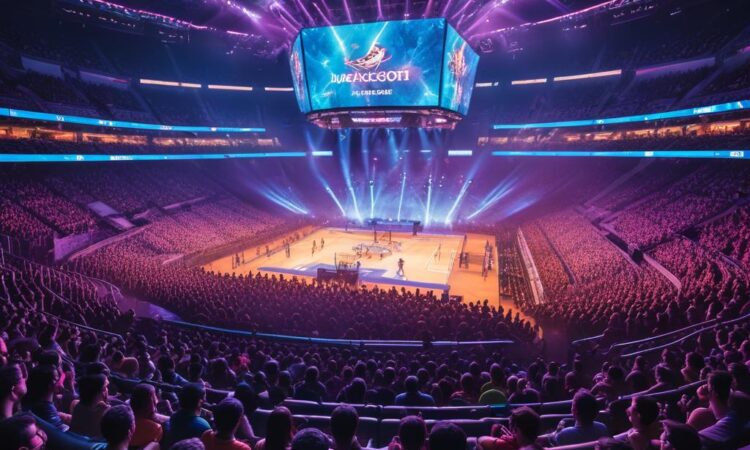The Impact of Esports on Gaming Culture: Analyzing how esports has influenced the development of video games, pushing for competitive features, increasing production value, and inspiring new game genres.
Esports, the competitive realm of video gaming, has rapidly ascended from a niche phenomenon to a global entertainment juggernaut. Beyond its own flourishing industry, esports has had a profound impact on the broader gaming culture, shaping the very landscape of video game development, production, and even genre innovation. This essay delves into the intricate ways esports has influenced gaming culture, analyzing how it has pushed for competitive features, elevated production values, and birthed new genres of gameplay.
Competitive Features: From Casual to Competitive
One of the most evident impacts of esports on gaming culture is the rise of competitive features within video games. Developers, inspired by the success and viewership of esports, have increasingly designed and implemented features specifically geared towards competitive play. This includes:
- Balanced Gameplay: Esports demand a high level of balance, ensuring that skill and strategy, not luck or overpowered elements, are the primary determinants of victory. Developers have thus prioritized game balancing, implementing adjustments and patches to ensure a level playing field for competitors and viewers alike. This emphasis on balance has trickled down to casual players, who also benefit from a fairer and more enjoyable experience.
- Ranked Systems and Leaderboards: The drive to create a competitive environment has led to the proliferation of ranked systems and leaderboards. These features provide a structured ladder for players to climb, showcasing their skill and rewarding them for their dedication. Ranked systems also incentivize players to improve, fostering a culture of continuous learning and skill development within the gaming community.
- Observability Tools: Esports demands a clear and engaging viewing experience. Games have incorporated spectator modes, allowing viewers to follow the action from different perspectives, understand the intricacies of gameplay, and fully appreciate the skill of the players. This has fostered a sense of community and shared experience amongst both players and viewers, further amplifying the appeal of esports.
The integration of these competitive features has not only enhanced the esports experience but has also fundamentally changed the way many video games are designed and played. It has ushered in an era where competitive gaming is no longer a niche activity, but an integral part of the gaming experience for millions of players worldwide.
Production Value: From Pixels to Spectacle
Esports has also significantly impacted the production values of video games. The demand for high-quality, visually stunning gameplay to captivate large audiences has motivated developers to invest heavily in graphics, audio, and overall presentation. This shift towards higher production values has benefitted both esports and the broader gaming landscape.
- Enhanced Graphics and Visual Fidelity: The need to showcase competitive action in a visually compelling manner has driven the adoption of advanced graphics engines, rendering techniques, and detailed character models. This not only enhances the viewing experience for esports audiences but also elevates the overall visual quality of games for all players.
- Immersive Sound Design: To create a truly immersive experience, esports has emphasized the importance of high-quality audio. Developers have invested in advanced audio engines, detailed sound effects, and dynamic soundtracks, enhancing the emotional impact and tension of gameplay, both for players and viewers.
- Focus on Storytelling and Worldbuilding: The popularity of esports has led to a greater emphasis on narrative and worldbuilding in video games. Games that offer compelling storylines, rich environments, and engaging characters are more likely to attract both players and viewers, enhancing the overall experience and promoting further engagement.
The increased production value driven by esports has pushed the boundaries of what video games can achieve, resulting in visually stunning and immersive experiences that have redefined the medium as a whole. It has not only made video games more visually appealing but also enriched the overall narrative and gameplay experience.
New Game Genres: From Traditional to Unique
Esports has not only influenced established genres but has also inspired the creation of entirely new game genres. The demand for competitive gameplay and the desire to cater to specific esports audiences have led to the emergence of games specifically designed for competitive play, often featuring unique mechanics and rulesets.
- Battle Royale: The \”battle royale\” genre, epitomized by games like Fortnite and PUBG, owes its immense popularity in part to its suitability for competitive play. The focus on last-man-standing gameplay, combined with the element of strategic decision-making, has made battle royale games a staple of esports tournaments and a popular choice for viewers and players alike.
- MOBA (Multiplayer Online Battle Arena): Games like League of Legends and Dota 2 have revolutionized competitive gaming with their strategic depth, team-based play, and intricate character dynamics. MOBAs have become a cornerstone of esports, boasting dedicated leagues, tournaments, and a massive global fan base.
- Hero Shooters: Games like Overwatch and Valorant have combined the fast-paced action of first-person shooters with the character-based gameplay of MOBAs. These games have found significant success in esports, attracting viewers with their diverse hero roster, strategic team compositions, and intense competitive matches.
The creation of these new genres has broadened the scope of competitive gaming, offering players and viewers a wider variety of experiences and gameplay styles. It has also demonstrated the adaptability and innovation of the gaming industry, constantly evolving and responding to the ever-changing demands of its audience.
Conclusion: A Symbiotic Relationship
The relationship between esports and gaming culture is symbiotic. Esports has spurred the development of competitive features, heightened production values, and inspired new game genres, enriching the overall gaming experience for millions of players worldwide. In return, the growing popularity of gaming and the expansion of its audience have provided esports with a platform for its own growth and global reach. The future of gaming is intertwined with the trajectory of esports, promising further innovations, advancements, and a continued evolution of the gaming landscape.

